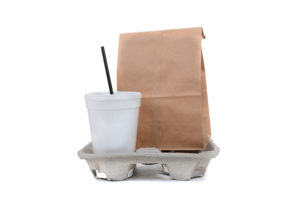 Restaurants are the most common setting for food poisoning outbreaks and, as a look at recent E. coli outbreaks reveals, fast food and fast-casual restaurants are no exception. Jimmy John’s, Evergreens and Chipotle have all been linked to recent E. coli outbreaks.
Restaurants are the most common setting for food poisoning outbreaks and, as a look at recent E. coli outbreaks reveals, fast food and fast-casual restaurants are no exception. Jimmy John’s, Evergreens and Chipotle have all been linked to recent E. coli outbreaks.
Jimmy John’s Clover Sprout E. coli O103 Outbreak
Earlier this year, Jimmy John’s was linked to a 10-state E. coli O103 outbreak linked to contaminated clover sprouts. Fifty-one people were sickened, three people were hospitalized.
Most of the illnesses were reported from Utah where 34 people fell ill. The number of illnesses reported from other states was: Florida (1), Idaho (1), Illinois (7), Iowa (3), Missouri (1), New York (1), Texas (1), Virginia (1), Wyoming (1).
Health officials used Whole Genome Sequencing (WGS) to identify the genetic “fingerprint” of the outbreak strain cultured from patients and found that it closely resembled the one cultured from samples of clover sprouts produced by Chicago Indoor Garden. The U.S. Food and Drug Administration (FDA) issued a warning to consumers about the clover sprouts, three days later, Chicago Indoor issued a recall.
The FDA then discovered that the same seed lot linked to this outbreak was also linked to the Jimmy John’s clover sprout E. coli outbreak in Iowa in late 2019. Contaminated sprouts have been a frequent source of food poisoning outbreaks at Jimmy John’s. The sandwich shop chain has been linked to nine outbreaks over the last 11 years associated with sprouts or other produce. The company has previously halted sales of sprouts but said in February 2020 that is removing them from the menu permanently.
Contact the Pritzker Hageman E. coli Team
Phone: 1-888-377-8900 | Text: 1-612-261-0856
Evergreens E. coli O157:H7 Outbreak
In November 2019, an E. coli outbreak linked to Evergreens restaurants sickened 16 people who ate at seven different locations in King County, WA. Three people were hospitalized.
The outbreak occurred at the same time a multi-state E. coli O157:H7 outbreak linked to romaine lettuce grown in Salinas Valley, CA that sickened 167 people, 85 of whom were hospitalized. However, WGS tests determined that the outbreaks weren’t caused by the same strain of E. coli.
Chipotle E. coli O26 Outbreaks
In 2015, two E. coli O26 outbreaks were linked to Chipotle restaurants. The specific food item was never pinpointed, but that information is not required to file a lawsuit. In fact, the E. coli lawyers at Pritzker Hageman filed the first lawsuit against Chipotle in this outbreak on behalf of a client who developed an E. coli infection after eating a burrito bowl on October 21, 2015.
The larger outbreak included 55 illnesses in 11 states: California (3), Delaware (1), Illinois (1), Kentucky (1), Maryland (1), Minnesota (2), New York (1), Ohio (3), Oregon (13), Pennsylvania (2), Washington (27). Twenty-one ill people were hospitalized.
The smaller outbreak included 5 people in three states: Kansas (1), North Dakota (1), and Oklahoma (3). One ill person was hospitalized
Related
Can I Sue a Restaurant for Food Poisoning?
Can I Sue Chipotle for E. coli O26?
COVID-19 Impact on Dining Out
Each year, the Centers for Disease Control and Prevention (CDC) releases a report about foodborne illness outbreaks. In 2017, the most current year for which the agency has published data, restaurants were associated with 489 outbreaks or about 64 percent of outbreaks where food was prepared at a single location.
The coronavirus outbreak has shifted restaurant consumers away from dining in and toward take-out, delivery and drive-through meals. Some fast food and fast-casual companies have reported that this shift has been a boost to the bottom line.
Symptoms of an E. coli Infection
Symptoms of an E. coli infection include abdominal cramps and diarrhea that can be bloody. These symptoms usually develop within one to five days of exposure. Between 5 and 10 percent of people with E. coli infections develop a complication called hemolytic uremic syndrome (HUS). Symptoms of HUS, usually develop about a week after E. coli symptoms. They include bloody diarrhea, a decrease in urination, bloody urine, pale skin, skin that bruises easily, fatigue, irritability, confusion and swelling of the face, hands, feet and body. Anyone experiencing these symptoms should seek medical care immediately.
If you developed an E. coli infection from contaminated restaurant food and would like a free consultation with an experienced E. coli lawyer, please contact the Pritzker Hageman E. coli Legal Team. We have represented clients in every major E. coli outbreak in the U.S. We’ve taken on big companies and won and we don’t get paid unless we win. You can reach us by calling 1-888-377-8900, sending a text to 612-261-0856, or by completing the form below. The consultation is free and there is no obligation.